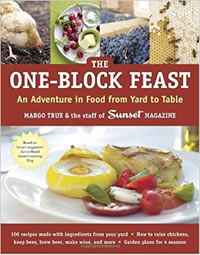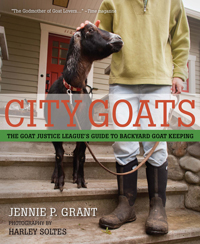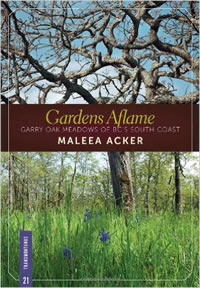 From a publisher a bit out of the region but very familiar to us all is The One-Block Feast by Margo True and the staff of Sunset Magazine. Essentially this is a scrapbook of the an on-going experiment to grow, harvest, prepare, and cook a full menu, all from very local sources–the Menlo Park, California campus of this long-time fount of wisdom for gardeners throughout the west.
From a publisher a bit out of the region but very familiar to us all is The One-Block Feast by Margo True and the staff of Sunset Magazine. Essentially this is a scrapbook of the an on-going experiment to grow, harvest, prepare, and cook a full menu, all from very local sources–the Menlo Park, California campus of this long-time fount of wisdom for gardeners throughout the west.
While one must make modifications for the Pacific Northwest (a calendar of regionally adjusted planting and harvesting dates in the appendix will help), you can’t help but come away from reading this book full of ideas. The staff formed teams by food type, and weren’t afraid to tackle almost anything from honey to cheese, or beer to olive oil. I thought the stories of Team Salt and Team Escargot were the most intriguing.
Excerpted from the Spring 2013 Arboretum Bulletin.
 Jennie P. Grant brings a full measure of enthusiasm to “City Goats,” a combination how-to manual, goat keeping manifesto, and love story, made all the better by its Seattle setting. While much of the care-giving information would apply to goats anywhere, the author’s campaign to legalize her herd is especially compelling because of its local connections.
Jennie P. Grant brings a full measure of enthusiasm to “City Goats,” a combination how-to manual, goat keeping manifesto, and love story, made all the better by its Seattle setting. While much of the care-giving information would apply to goats anywhere, the author’s campaign to legalize her herd is especially compelling because of its local connections.
I’m not likely to start my own herd, but I couldn’t help getting hooked by the exploits and personalities of Brownie, Snowflake, Maple, and Eloise. Is this a gardening book? Perhaps not, as the author makes it very clear that your goats and your roses are not good companions. However as the model of the urban farm continues to flourish, you may embrace having your own source of milk and veggies, from securely separated sites, of course.
Excerpted from the Spring 2013 Arboretum Bulletin.
 “Garlic! Grow West of the Cascades” is a charming and infectious little book–that will make you eager to grow lots of this culinary staple. At least, that was my reaction as Frank Parente has an enthusiasm rarely matched by other garden writers. Based on Whidbey Island, but channeling his garden loving, Italian ancestors on both sides of his family tree, he writes to “…cover some pointers that will ensure success in wet and humid Western Washington.”
“Garlic! Grow West of the Cascades” is a charming and infectious little book–that will make you eager to grow lots of this culinary staple. At least, that was my reaction as Frank Parente has an enthusiasm rarely matched by other garden writers. Based on Whidbey Island, but channeling his garden loving, Italian ancestors on both sides of his family tree, he writes to “…cover some pointers that will ensure success in wet and humid Western Washington.”
You will need these pointers, as the many varieties of garlic require specialized handling for optimum results. But don’t worry; the author takes you carefully through the many selections. He also spares no detail on soil preparation, planting, harvesting, curing, and storing, all supplemented with his instructive photographs and diagrams. You’re in good hands!
Excerpted from the Spring 2013 Arboretum Bulletin.

“From the Hands of a Weaver” is a history of basket making on the Olympic Peninsula, edited by Jacilee Wray. Gardening was an important part of this craft as “…sophisticated techniques conducted by indigenous cultures altered the landscape, the species composition, and individual plants, ensuring that the highest-quality basketry materials were continuously available for use.”
Several plants were used in this craft, ranging from the mighty cedars (Thuja plicata) to more humble beargrass (Xerophyllum tenax), but all required intimate knowledge of these plants for the best results. I found the practices used by the different tribes, from plant selection and harvest to the design and production of the baskets, very engaging.
Excerpted from the Spring 2013 Arboretum Bulletin.

Gardens have taken many forms, depending on the time and culture nurturing them. “Gardens Aflame” considers the gardens created by the indigenous people of the greater Victoria area before the arrival of Europeans. At first, we might not recognize these spaces as gardens, but the Garry Oak (Quercus garryana) meadows were carefully maintained to provide valuable camas roots (Camassia quamash and C. leichtlinii), a staple of the native diet.
Maleea Acker takes a keen interest in the history of these meadows and the efforts to preserve and restore them. As one would expect, these are under threat from expanding development and invasive species. But another challenge comes as the native people can no longer provide the management that kept more aggressive native species (especially Douglas-fir, Pseudotsuga menziesii) from encroaching.
“Meadows were kept clear by the Coast Salish for thousands of years before the arrival of Europeans, and served as a food source for many First Nations up and down the west coast and into the Interior.” While camas was the main crop, other plants were also harvested, and the gardens became important places for people to gather, just as they are today.
Excerpted from the Spring 2013 Arboretum Bulletin.

“Edible Landscaping” is not your typical vegetable gardening book. You will not find an A-Z encyclopedic listing of popular vegetables, nor is there much cultural information specific to each crop. Instead, this is a garden design book with an eye to making edible plants the key feature.
Author Senga Lindsay, a landscape designer and gardener in North Vancouver, B.C., challenges and encourages you, the home gardener, to take charge of your garden’s appearance and assumes that you don’t want your “…yard to look like a ‘dog’s breakfast’–messy, unkempt and utilitarian.” After outlining basic planning steps, she presents fifteen different model gardens, each with detailed plans, lists of needed supplies, and step-by-step procedures for installation.
These plans range from the traditional row garden to green roofs and walls to parking strips. Your garden may need to satisfy a gourmet chef, or accommodate a disabled gardener, or engage young children–all are addressed with the same level of detail. While you can follow one plan to the letter, the elements from the plans can easily be blended as needed.
Excerpted from the Spring 2013 Arboretum Bulletin.
 A good book to help those of us living on tiny urban lots, or in the even smaller spaces of condominiums and townhouses is Big Ideas for Northwest Small Gardens by Marty Wingate. It guides the city gardener through design consideration and appropriate plant selection. One chapter answers common questions city gardeners have, such as “Can I have a wildlife garden?” Color photography by Jacqueline Koch helps make this informative book a pleasure to read.
A good book to help those of us living on tiny urban lots, or in the even smaller spaces of condominiums and townhouses is Big Ideas for Northwest Small Gardens by Marty Wingate. It guides the city gardener through design consideration and appropriate plant selection. One chapter answers common questions city gardeners have, such as “Can I have a wildlife garden?” Color photography by Jacqueline Koch helps make this informative book a pleasure to read.
 The Seattle based authors of Food Grown Right, in Your Backyard operate a business that gets homeowners started growing their own vegetables (along with herbs, edible flowers, and a few berry fruits) no matter what the challenges may come from inexperience or a difficult site. Colin McCrate and Brad Halm advice is great for beginners, providing a lot of structure and many details while including a teaching element with every entry. For example, by growing radishes you’ll learn how to harvest at the right time for the best taste, while planting corn will teach you about wind pollination.
The Seattle based authors of Food Grown Right, in Your Backyard operate a business that gets homeowners started growing their own vegetables (along with herbs, edible flowers, and a few berry fruits) no matter what the challenges may come from inexperience or a difficult site. Colin McCrate and Brad Halm advice is great for beginners, providing a lot of structure and many details while including a teaching element with every entry. For example, by growing radishes you’ll learn how to harvest at the right time for the best taste, while planting corn will teach you about wind pollination.
Excerpted from the Winter 2013 Arboretum Bulletin.
 Graham Kerr is an (now local–Mt. Vernon) author who easily includes recipes amongst his recommendations for a kitchen garden, but that’s not surprising as he is much better known as a chef (remember the Galloping Gourmet) than a gardener. He has embraced raising his own, healthful food as eagerly as any of his past pursuits. Growing at the Speed of Life is filled with the same enthusiasm–Kerr hasn’t lost any of his wit or knack of turning a phrase that made him such a popular television personality in the early 1970s.
Graham Kerr is an (now local–Mt. Vernon) author who easily includes recipes amongst his recommendations for a kitchen garden, but that’s not surprising as he is much better known as a chef (remember the Galloping Gourmet) than a gardener. He has embraced raising his own, healthful food as eagerly as any of his past pursuits. Growing at the Speed of Life is filled with the same enthusiasm–Kerr hasn’t lost any of his wit or knack of turning a phrase that made him such a popular television personality in the early 1970s.
Excerpted from the Winter 2013 Arboretum Bulletin.
 Lorene Edwards Forkner has addressed a real need on the Garden Library bookshelf. While there are a handful of books (none of them by local authors) about using foraged materials for garden decoration, none adequately take the next step of using these materials to create useful yet attractive objects that we all need in our gardens. Handmade Garden Projects has everything from fountains to potting benches with clear instructions and lots of encouragement to build these yourself, at a fraction of the cost of having someone else be your handy man or woman. Another plus: many of the examples are from gardens created by familiar people in the Seattle area horticultural community.
Lorene Edwards Forkner has addressed a real need on the Garden Library bookshelf. While there are a handful of books (none of them by local authors) about using foraged materials for garden decoration, none adequately take the next step of using these materials to create useful yet attractive objects that we all need in our gardens. Handmade Garden Projects has everything from fountains to potting benches with clear instructions and lots of encouragement to build these yourself, at a fraction of the cost of having someone else be your handy man or woman. Another plus: many of the examples are from gardens created by familiar people in the Seattle area horticultural community.
Excerpted from the Winter 2013 Arboretum Bulletin.
 From a publisher a bit out of the region but very familiar to us all is The One-Block Feast by Margo True and the staff of Sunset Magazine. Essentially this is a scrapbook of the an on-going experiment to grow, harvest, prepare, and cook a full menu, all from very local sources–the Menlo Park, California campus of this long-time fount of wisdom for gardeners throughout the west.
From a publisher a bit out of the region but very familiar to us all is The One-Block Feast by Margo True and the staff of Sunset Magazine. Essentially this is a scrapbook of the an on-going experiment to grow, harvest, prepare, and cook a full menu, all from very local sources–the Menlo Park, California campus of this long-time fount of wisdom for gardeners throughout the west. Jennie P. Grant brings a full measure of enthusiasm to “City Goats,” a combination how-to manual, goat keeping manifesto, and love story, made all the better by its Seattle setting. While much of the care-giving information would apply to goats anywhere, the author’s campaign to legalize her herd is especially compelling because of its local connections.
Jennie P. Grant brings a full measure of enthusiasm to “City Goats,” a combination how-to manual, goat keeping manifesto, and love story, made all the better by its Seattle setting. While much of the care-giving information would apply to goats anywhere, the author’s campaign to legalize her herd is especially compelling because of its local connections. “Garlic! Grow West of the Cascades” is a charming and infectious little book–that will make you eager to grow lots of this culinary staple. At least, that was my reaction as Frank Parente has an enthusiasm rarely matched by other garden writers. Based on Whidbey Island, but channeling his garden loving, Italian ancestors on both sides of his family tree, he writes to “…cover some pointers that will ensure success in wet and humid Western Washington.”
“Garlic! Grow West of the Cascades” is a charming and infectious little book–that will make you eager to grow lots of this culinary staple. At least, that was my reaction as Frank Parente has an enthusiasm rarely matched by other garden writers. Based on Whidbey Island, but channeling his garden loving, Italian ancestors on both sides of his family tree, he writes to “…cover some pointers that will ensure success in wet and humid Western Washington.”


 A good book to help those of us living on tiny urban lots, or in the even smaller spaces of condominiums and townhouses is Big Ideas for Northwest Small Gardens by Marty Wingate. It guides the city gardener through design consideration and appropriate plant selection. One chapter answers common questions city gardeners have, such as “Can I have a wildlife garden?” Color photography by Jacqueline Koch helps make this informative book a pleasure to read.
A good book to help those of us living on tiny urban lots, or in the even smaller spaces of condominiums and townhouses is Big Ideas for Northwest Small Gardens by Marty Wingate. It guides the city gardener through design consideration and appropriate plant selection. One chapter answers common questions city gardeners have, such as “Can I have a wildlife garden?” Color photography by Jacqueline Koch helps make this informative book a pleasure to read. The Seattle based authors of Food Grown Right, in Your Backyard operate a business that gets homeowners started growing their own vegetables (along with herbs, edible flowers, and a few berry fruits) no matter what the challenges may come from inexperience or a difficult site. Colin McCrate and Brad Halm advice is great for beginners, providing a lot of structure and many details while including a teaching element with every entry. For example, by growing radishes you’ll learn how to harvest at the right time for the best taste, while planting corn will teach you about wind pollination.
The Seattle based authors of Food Grown Right, in Your Backyard operate a business that gets homeowners started growing their own vegetables (along with herbs, edible flowers, and a few berry fruits) no matter what the challenges may come from inexperience or a difficult site. Colin McCrate and Brad Halm advice is great for beginners, providing a lot of structure and many details while including a teaching element with every entry. For example, by growing radishes you’ll learn how to harvest at the right time for the best taste, while planting corn will teach you about wind pollination. Graham Kerr is an (now local–Mt. Vernon) author who easily includes recipes amongst his recommendations for a kitchen garden, but that’s not surprising as he is much better known as a chef (remember the Galloping Gourmet) than a gardener. He has embraced raising his own, healthful food as eagerly as any of his past pursuits. Growing at the Speed of Life is filled with the same enthusiasm–Kerr hasn’t lost any of his wit or knack of turning a phrase that made him such a popular television personality in the early 1970s.
Graham Kerr is an (now local–Mt. Vernon) author who easily includes recipes amongst his recommendations for a kitchen garden, but that’s not surprising as he is much better known as a chef (remember the Galloping Gourmet) than a gardener. He has embraced raising his own, healthful food as eagerly as any of his past pursuits. Growing at the Speed of Life is filled with the same enthusiasm–Kerr hasn’t lost any of his wit or knack of turning a phrase that made him such a popular television personality in the early 1970s. Lorene Edwards Forkner has addressed a real need on the Garden Library bookshelf. While there are a handful of books (none of them by local authors) about using foraged materials for garden decoration, none adequately take the next step of using these materials to create useful yet attractive objects that we all need in our gardens.
Lorene Edwards Forkner has addressed a real need on the Garden Library bookshelf. While there are a handful of books (none of them by local authors) about using foraged materials for garden decoration, none adequately take the next step of using these materials to create useful yet attractive objects that we all need in our gardens.